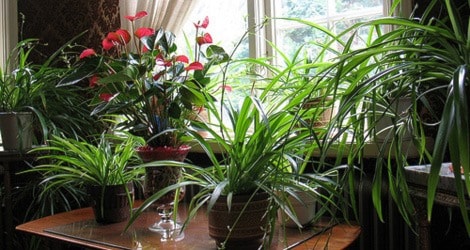This is one of the worst times of the year for our indoor plants due to the extra warmth from heaters and fireplaces and the low humidity inside our homes. The short daylight hours do not help either. Things get better as we inch along with increasing daylight, however, there are a number of important things we can do to get our plants back in shape.
One of the most important, yet often overlooked, ways of helping our plants is to change the air inside our homes. Open those doors and windows, even for a short while, to get some fresh air inside! A fresh supply of air is essential for plants, especially at this time of year. Even on the coldest days of winter, we always open the air vents of our greenhouses during the warmest part of the day to allow an exchange of air. The movement of air is also critical to prevent mildew and other fungal diseases. Many folks simply switch on the summer fan in their furnace, but a small circulatory fan can do the job nicely. With both fresh air and air movement, you too will find the atmosphere in your home feels better.
It is also time to give your plants a good shower. Any dust that has collected on them creates an ideal breeding ground for pests. Washing it off with a soft, warm shower is one of the best things you can do to promote their health. Do not get the soil saturated, just wash the foliage. (This only applies to smooth leafed plants, not to violets and other flowering plants.) Your plants will be clean and fresh, and the moisture will discourage spider mites. It might also be a good idea, once the plants are all in the shower, to spray them with a safe, organic pesticide, such as Safer’s soap products. Preventative organic programs, when used on a regular basis, will prevent most pest problems. They should, however, be applied with a small pressure sprayer as the spray must completely cover all parts of the plant, especially the undersides of the leaves, if it is to be effective. Use only warm water when you spray to avoid shocking your plants.
When you put your plants back in their traditional location, be sure to rotate them regularly so all sides of the plant receive light. At this time of year, it might be wise to keep them close to east or north windows, or at least open the curtains wide to brighten your rooms. Extra lighting for 16 hours a day from Power Smart fixtures will also promote more vegetative growth on many plants.
Proper watering is the most critical factor for the survival of all your plants. The only true way of telling if a plant needs water is by lifting the pot and feeling its weight. If the pot feels light, the plant needs water; if it feels heavy, do not water. At this time of year, you may only need to water two or three times per month, but when you do, really soak your plants thoroughly with warm water, then let them dry out. This only applies to rootbound plants. If your plants are not rootbound, downsize!
I’m surprised so many folks are wanting to transplant their indoor plants to larger pots at this time of year – don’t! Plants love to be rootbound in a smaller container, so no repotting should be done until at least mid-April when the growing cycle returns.
Plants that are under severe stress should be covered loosely with a clear, lightweight poly bag to create a micro-climate. Placing three or four bamboo stakes in the pot will help keep the poly off the leaves. Mist the plant frequently to increase humidity. You will be surprised to see how this treatment will improve the condition of your plants. This is especially true for citrus.
This is one of the most difficult times of the year for our indoor plants, and they do require some help. Please give them the attention they need now to get them through the rest of winter so that come spring, they will bounce back with full, lush, healthy growth.
If you want to introduce some fresh life to your home by adding new tropicals, there are some very low-light tolerant and resilient plants. The entire dracaena family, especially the dragon plant (Dracaena marginata), is tops. Philodendrons, from the low spreading P. selloum and the staked and narrow pothos to the many new and colourful lime and burgundy varieties, are attractive and easy. The peace lily, with its elegant white flowers, the spiky sansevieria and the beautifully coloured foliage of ctenanthe are also amazing.
